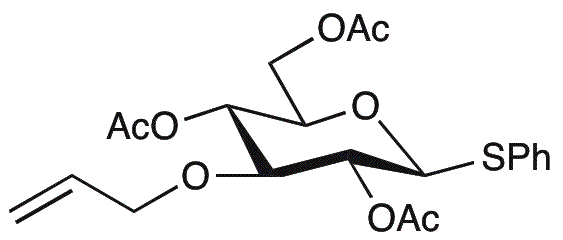Phenyl 2,4,6-tri-O-acetyl-3-O-allyl-1-thio-b-D-glucopyranoside is widely utilized in research focused on:
- Glycosylation Reactions: This compound serves as a glycosyl donor in synthetic chemistry, facilitating the formation of glycosidic bonds, which are crucial in creating complex carbohydrates.
- Drug Development: Its unique structure allows researchers to explore new drug candidates, particularly in the development of glycosylated pharmaceuticals that can enhance bioavailability and efficacy.
- Bioconjugation: It is employed in bioconjugation techniques to attach biomolecules to surfaces or other molecules, improving the functionality of diagnostic tools and therapeutic agents.
- Research in Carbohydrate Chemistry: The compound is pivotal in studies aimed at understanding carbohydrate interactions and their biological roles, aiding in the exploration of new therapeutic targets.
- Food Industry Applications: Its derivatives can be used in flavoring and preservation, enhancing the sensory properties of food products while maintaining safety and stability.
General Information
Properties
Safety and Regulations
Applications
Phenyl 2,4,6-tri-O-acetyl-3-O-allyl-1-thio-b-D-glucopyranoside is widely utilized in research focused on:
- Glycosylation Reactions: This compound serves as a glycosyl donor in synthetic chemistry, facilitating the formation of glycosidic bonds, which are crucial in creating complex carbohydrates.
- Drug Development: Its unique structure allows researchers to explore new drug candidates, particularly in the development of glycosylated pharmaceuticals that can enhance bioavailability and efficacy.
- Bioconjugation: It is employed in bioconjugation techniques to attach biomolecules to surfaces or other molecules, improving the functionality of diagnostic tools and therapeutic agents.
- Research in Carbohydrate Chemistry: The compound is pivotal in studies aimed at understanding carbohydrate interactions and their biological roles, aiding in the exploration of new therapeutic targets.
- Food Industry Applications: Its derivatives can be used in flavoring and preservation, enhancing the sensory properties of food products while maintaining safety and stability.
Documents
Safety Data Sheets (SDS)
The SDS provides comprehensive safety information on handling, storage, and disposal of the product.
Product Specification (PS)
The PS provides a comprehensive breakdown of the product’s properties, including chemical composition, physical state, purity, and storage requirements. It also details acceptable quality ranges and the product's intended applications.
Certificates of Analysis (COA)
Search for Certificates of Analysis (COA) by entering the products Lot Number. Lot and Batch Numbers can be found on a product’s label following the words ‘Lot’ or ‘Batch’.
Numéro de catalogue
Numéro de lot/série
Certificates Of Origin (COO)
This COO confirms the country where the product was manufactured, and also details the materials and components used in it and whether it is derived from natural, synthetic, or other specific sources. This certificate may be required for customs, trade, and regulatory compliance.
Numéro de catalogue
Numéro de lot/série
Safety Data Sheets (SDS)
The SDS provides comprehensive safety information on handling, storage, and disposal of the product.
DownloadProduct Specification (PS)
The PS provides a comprehensive breakdown of the product’s properties, including chemical composition, physical state, purity, and storage requirements. It also details acceptable quality ranges and the product's intended applications.
DownloadCertificates of Analysis (COA)
Search for Certificates of Analysis (COA) by entering the products Lot Number. Lot and Batch Numbers can be found on a product’s label following the words ‘Lot’ or ‘Batch’.
Numéro de catalogue
Numéro de lot/série
Certificates Of Origin (COO)
This COO confirms the country where the product was manufactured, and also details the materials and components used in it and whether it is derived from natural, synthetic, or other specific sources. This certificate may be required for customs, trade, and regulatory compliance.

